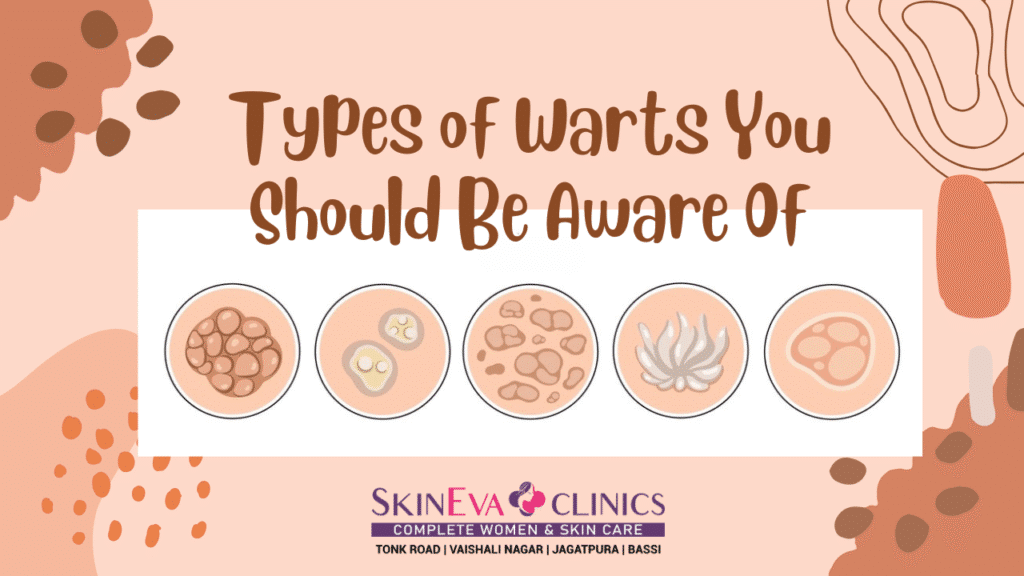Types of Warts You Should Be Aware Of

Warts are circumscribed, non-malignant dermatological excrescences caused by an infection with the human papillomavirus (HPV). The virus gains access to the epidermal layer through minor cutaneous breaches, stimulating an abnormal proliferation of epithelial cells, which culminates in the formation of a wart. Despite their generally benign nature, these lesions are highly transmissible through direct interpersonal contact or indirectly via contaminated surfaces. The morphology of warts is diverse, ranging from flat (verruca plana) to pedunculated (filiform) or hyperkeratotic lesions, and their localization can be ubiquitous across the body surface. Each type of wart is linked to a specific strain of HPV and may require a different approach for identification and treatment.
In this blog, we will take an in-depth look at the different types of warts you should be aware of.
1️. Common Warts (Verruca Vulgaris)
Common warts are the most frequently seen kind, typically found on the hands, fingers, or knees. They’re rough, raised, and rounded, often with a surface resembling cauliflower. Sometimes, small black dots (clotted capillaries) can be seen inside. These warts are caused by several strains of HPV, especially types 2 and 4. Although harmless, they can be bothersome and may spread if scratched or picked.
2️. Plantar Warts (Verruca Plantaris)
Plantar Warts (Verruca Plantaris): Found on the soles of your feet, these warts grow inward due to pressure from walking. Unlike common warts, they can be flat and painful, especially in areas where you put weight. In some cases, they appear in clusters called mosaic warts, especially under toes or the balls of the feet. HPV types 1, 2, 4, 27, and 57 are commonly involved.
3️. Flat Warts (Verruca Plana)
These are small, flat, and slightly raised bumps that often appear in large clusters, sometimes up to a hundred at once. They’re commonly found on the face, neck, back of hands, arms, and legs. These warts are usually flesh-colored, pink, or brownish, and are less noticeable individually but can be bothersome in groups. They are caused by HPV types 3, 10, and 28 and are more common in children and teenagers.
4️. Filiform Warts (Digitate Warts)
These warts have a distinct, thread-like or finger-like appearance. They are often skin-colored and tend to grow quickly. Filiform warts commonly appear on the face—around the mouth, eyes, nose, or under the chin. They can be irritating due to their location and may cause cosmetic concern. HPV types 1, 2, 4, 27, and 29 are linked with these facial warts.
5️. Periungual Warts
Periungual warts that grow around or underneath the fingernails or toenails. They start small but can grow to disrupt the nail structure, leading to pain, discomfort, or nail deformity. These warts may be hard, cauliflower-like, and often result from nail biting or picking. They are considered a variant of common warts, but due to their location, they can be harder to treat and may lead to secondary infections.
6️. Genital Warts (Condyloma Acuminata)
These are a sexually transmitted infection (STI) caused by HPV types 6 and 11, which are different from the types that cause common skin warts. They appear on the genital, anal, or groin areas and may look like small, soft, skin-colored or pink growths with a rough surface or a cauliflower-like appearance. Though not always painful, they can cause significant distress and are strongly linked to cervical and other anogenital cancers. Medical consultation is crucial.
7️. Mosaic Warts
Mosaic warts are a cluster of multiple plantar warts, often appearing as a large patch on the soles of the feet or palms of the hands. These are usually flatter than individual plantar warts and can cause discomfort when walking. These warts may be white, pinhead-sized, and cover a large surface area if not treated. They are often caused by HPV type 2.
8️. Butcher’s Warts
These warts mostly affect people who handle raw meat, such as butchers, chefs, or meat processors. They appear on the hands and fingers and are typically large, stubborn, and recur frequently due to constant exposure to moist environments and raw tissues. HPV type 7 is commonly responsible. Butcher’s warts are occupational and should be treated promptly to prevent spread.
9️. Focal Epithelial Hyperplasia (Heck’s Disease)
This is a rare and harmless oral condition, mostly seen in children and teenagers. It presents as soft, painless, pale or mucosal-colored nodules on the lips, inside the cheeks, or tongue. Caused by HPV types 13 and 32, these warts often occur in clusters and may be mistaken for other oral lesions. While generally self-limiting, they may require treatment if persistent or bothersome.
Conclusion
Warts come in various forms, and knowing the specific type you’re dealing with is crucial for effective treatment. Whether it’s a common wart on your hand or a genital wart requiring medical attention, the sooner you get it diagnosed, the better your chances of avoiding complications and spread.
If you or someone you know is struggling with warts, don’t wait—consult a dermatologist for proper diagnosis and a treatment plan tailored to your skin type and lifestyle.



Leave a Comment